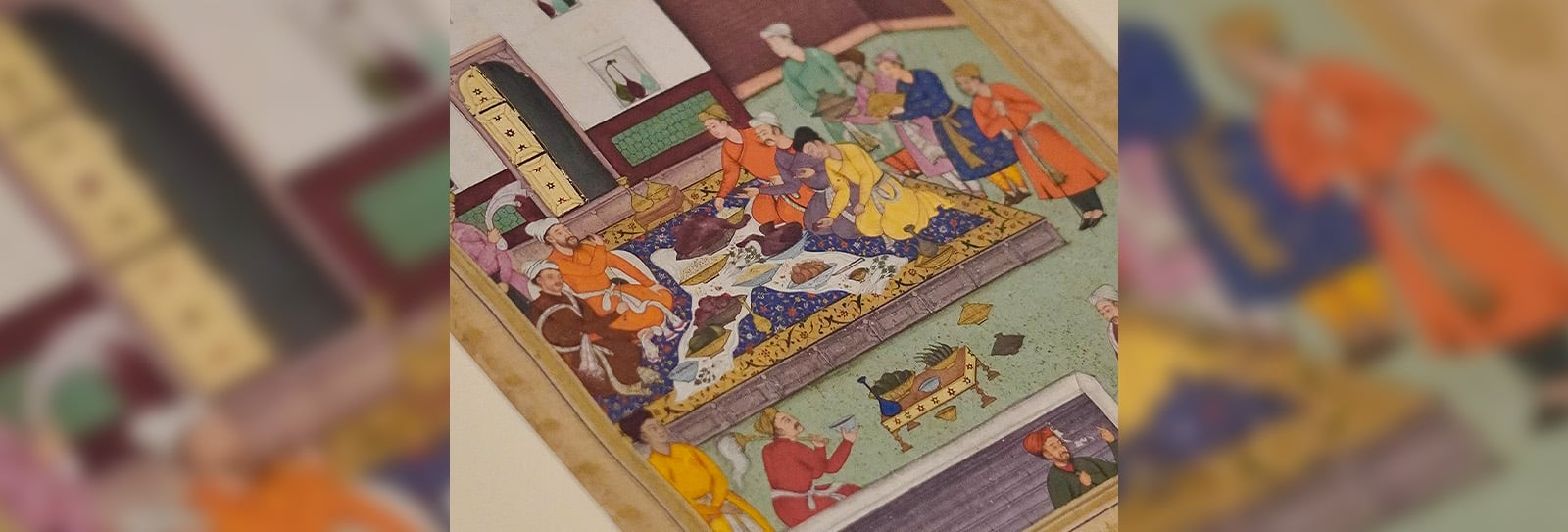
Hear from the Curator: Exhibition Explores Islamic Art via Food
The exhibition Dining With the Sultan, on view at the Los Angeles County Museum of Art, offers a feast for the eyes—and is the first to consider historical Islamic art within the context of serving fine food in various Muslim empires, according to curator Linda Komaroff.
A Look at Islamic Art in the Context of Food
Historically, many Muslim empires prized the sophisticated presentation of food, especially in formal settings, and perceived it as a point of pride for cooks and servers alike. Nowadays, some say the elegant display of those dishes is also a form of art.

Named to signal the setting of an Islamic court, Dining With the Sultan is the first exhibition to consider Islamic art within the context of food, according to Linda Komaroff, the department head and curator of Art of the Middle East at the Los Angeles County Museum of Art. The show explores an aspect of or influence in Islamic food culture over time through nine thematic sections, organizing some 250 illustrated manuscripts, pieces of tableware and cookbooks from 30 public and private collections across the US, Europe and the Middle East. The items, mostly dated from the eighth to 19th centuries, focus primarily on Arab, Persian, Ottoman and Mughal empires.
Komaroff spoke about the coordination and intentionality invested in the exhibition that gives viewers a look into the preparation and serving of food.
Why was the appearance of the dishware important to the presentation of a meal?

It is an art form to prepare the food, but it’s more the interrelationship between food and art, except that the act of dining was in high enough esteem in Islamic lands, especially among the elite that you would have an absolutely fabulous table where that would be worthy of the food that goes with it … . [In a tent depicted in a 10th-century cookbook featured at the exhibition], it becomes clear that not only is the taste and the aroma important but how the food looks as well. Sometimes they might make [dishware] that’s all black or green or white, but the dishware has contrast—decorating [the food] with almonds and pistachios dyed red or yellow. … Wouldn’t it be fun if after you emptied your bowl, it looked the same as when it was full or it reminded you of what it looked like when it was full?
What purpose did cookbooks serve?
The cookbooks are not really for cooks there … . It’s the kind of thing that someone would have in his library, but it would not end up in his kitchen. The cookbooks come under the heading of adab, or etiquette, targeted to a male audience. The person reading it would be more concerned about the types of dinners he’s going to, to be able to recognize, “This is such-and-such dish, and the history of the dish is such-and-such.”
To be a chef, someone in your family was probably a chef and you became an apprentice … . It’s the kind of thing that’s passed on. The same with recipes and variants of recipes. The cook would be taught. They either memorize [the recipes] or they took notes. … What you can see here is we’re dealing with a highly literate and sophisticated culture.


Left A luster-painted bowl is from ninth-century Iraq. Right Sadik Kwaish Alfraji’s multimedia installation recollects his mother’s homemade bread.

Tell us about the importance of serving food correctly.
From the time of Akbar, the Mughal emperor who ruled in India in the 16th century, there’s an entire [description] on how food was served. Literally once the food is prepared, someone tastes it to make sure it tastes good. [If so], it’s put into Chinese porcelain or some other bowl with a cover on top of it, and it’s secured with a ribbon and then someone signs it like a certification. So that’s how you know. I always joke that I don’t think he ever got to eat a hot meal because by the time all of this is done, it’s possibly not hot anymore.
What from the exhibition has carried over to the present day?
People like to see how the rich and famous live … . Elite objects—that’s what survives. Exclusively things that were precious and costly and needed to be, or someone wanted to save them.
We dine on glazed ceramic tableware even today. … It’s a very clean and eventually economical way to produce tableware because they’re easy to wash. [Additionally], coffee-making traditions are still the same. … A lot of the foods are the same. Sometimes the ingredients change, but the recipes live over a very long period of time.
What do you want visitors to take away from this exhibition?
How fabulous Islamic art is … . I’d like to think with art … .It does open your mind if you allow it to, to thinking a different way, which is something that’s important to me. … Because I don’t think we are going to arrive at a better place in this world if people can’t move closer to another person’s viewpoint.
You may also be interested in...

Mundane to Magnificent: Yale Manuscript Exhibition Illuminates Muslim Knowledge
Arts
Manuscript exhibition reveals handwritten treasures spanning centuries and nations, in graying script and glorious technicolor, on ancient papyrus and gold-coated paper.
‘Home’: Arab American National Museum Celebrates 20th Anniversary
Arts
Arab American National Museum Director Diana Abouali says the facility—which is marking its 20th anniversary in 2025—in Dearborn, Michigan, has aimed to create a home for Arab Americans by preserving and presenting the history, culture and contributions of Arab immigrants as well as their native-born children and grandchildren.
Orion Through a 3D-Printed Telescope
Arts
With his homemade telescope, Astrophotographer Zubuyer Kaolin brings the Orion Nebula close to home.